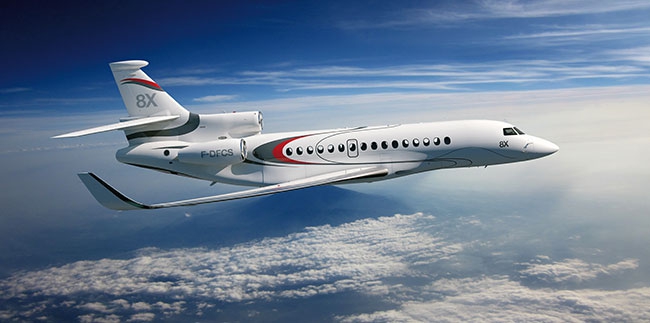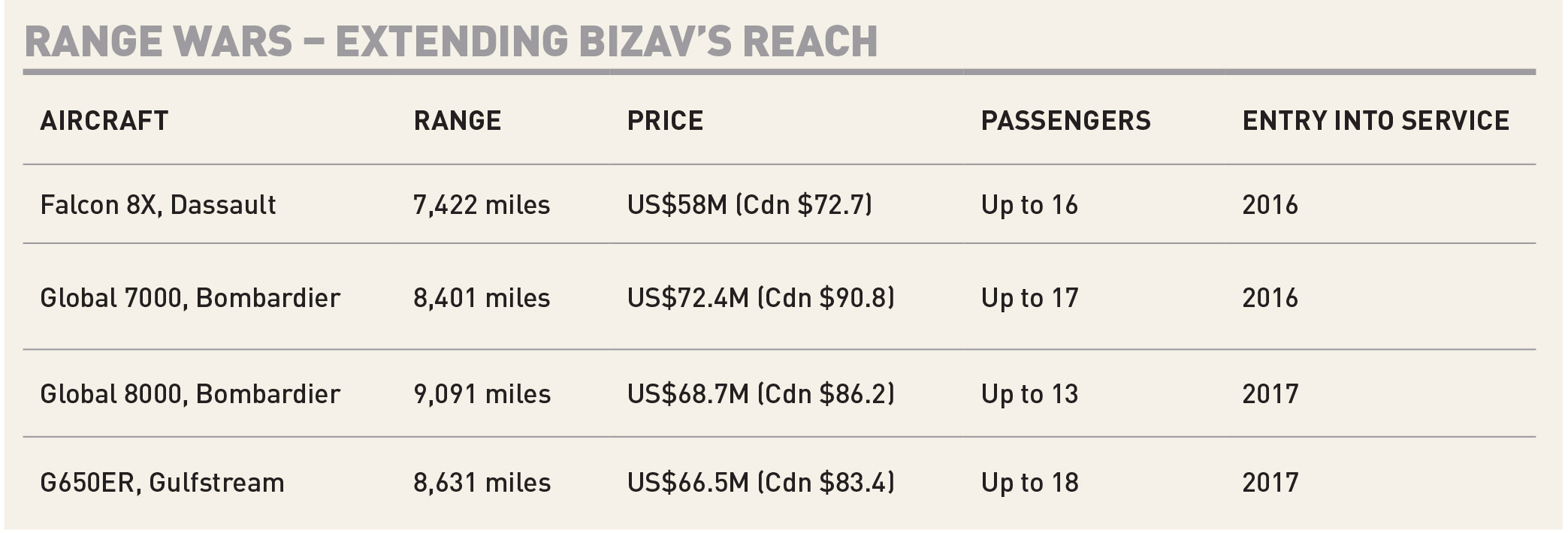
Features
Aircraft
Dassault adds an “X”
With longer-range jets continuing to dominate new business aircraft sales, Bordeaux, France-based Dassault Aviation fast-tracked its first ultra-long-range aircraft by stretching the highly regarded fly-by-wire Falcon 7X tri-jet. The new Falcon 8X was announced only a year ago at the European Business Aviation Conference and Exhibition (EBACE) in Geneva, Switzerland, but is already in test flight mode, and initial deliveries are proposed for late next year.
May 6, 2015 By Rick Adams
 In essence With longer-range jets continuing to dominate new business aircraft sales
In essence With longer-range jets continuing to dominate new business aircraft salesThere were two driving factors for the project, according to Frédéric Petit, who is in charge of all Falcon programs except for the in-development 5X and who initiated the market and design studies which led to the 8X. “When we launched the Falcon 8X program, we had two objectives in mind,” Petit told Wings. “First, increase the range of the aircraft compared to the 7X to access some important city pairs with Asia. We needed some significant extra range compared to a 7X.”
“In addition, we had in mind a good flexibility in cabin comforts, and this has been achieved by adding an extra metre to the cabin length, which allows us a number of different cabin configurations.”
In essence, Dassault stretched the Falcon 7X, which has enabled them to bring the 8X to market so quickly. The project was started in 2011 under the code name M1000. Petit said a primary reason for using an existing airframe is that “we were already working on the launch of the 5X, and we considered that keeping the 7X platform was the right decision in the amount of time and to enter the market very soon.”
Even so, this is the first time in Falcon history for parallel development and launch of two aircraft in less than a year. The all-new 5X super-mid-size aircraft was started in 2006 as the SMS, announced in 2013, and is expected to enter into service in 2017.
“It shows our unprecedented financial investment and confidence in our continued success in this market,” stated Eric Trappier, Dassault Aviation chairman
and CEO.
Common weight, common handling
Despite the extra length, the Falcon 8X at 80.2 feet (24.6 metres) will weigh in similar to its shorter 76.08 feet (23.2 metres) 7X predecessor – the same zero fuel weight of 41,000 pounds. The maximum takeoff weight for the 8X is 73,000 pounds.
“It has been done through significant weight reduction, especially in the wings,” Petit said. “They are the same external shape on the ground, but inside it’s significantly different with many weight reductions everywhere in the wings – mainly reduced thickness on panels and ribs – a half millimetre here, a quarter millimetre somewhere else.”
Altogether, Dassault designers saved about 250 kilograms (600 pounds) across the wing span. “There are some other areas where we have also done weight reduction, but the main contributor is the wings.”
A consequence of the weight reduction is that the wing shape changes slightly in flight. “It will be a little more flexible, and it has been designed in a way that is beneficial for the performance,” Petit noted.
Pilots “will not feel anything different” between flying the 8X and the 7X, Petit said. To cause the 8X to fly aerodynamically like the 7X, Dassault made adjustments in the flight control load to minimize overall aircraft drag. Indeed, Dassault hopes to achieve a common type rating between the two aircraft. “We need to finalize the 8X development and to have a very good knowledge ourselves of the differences, and then discuss with the training providers and regulators. It is too early in the program to tell the amount of differences,” he said.
FlightSafety International was selected as the factory authorized provider for the Falcon 8X, and will initially build two Level D flight simulation training devices to coincide with the 2016 entry into service. One simulator will be located at FlightSafety’s Teterboro, N.J. centre in the U.S. and the other in Paris, France.
The 8X cockpit will feature the third-generation EASy (Enhanced Avionics System) integrated flight deck, Dassault’s version of Honeywell’s Primus Epic avionics – including three-dimensional depictions of hazardous weather – and a next-gen flight management system (FMS). The EASy III will also be on the new 5X, and Petit said it might be available in the future for the Falcon 900 and 2000 aircraft lines.
In addition to the four-panel graphical display, the Falcon 8X will offer an optional Combined Vision System (CVS): a “wide screen” head-up display (HUD) from Elbit Systems with both advanced infrared and simulation-like synthetic vision derived from a terrain database. Petit explained that, “Synthetic vision is for the sector that is far from the aircraft. Close to the aircraft, we move to infrared when you are within range of the sensor. The two systems on the same HUD will use “a clever algorithm” to determine the best image for the conditions.
Petit has been with Dassault for 25 years, starting as an engineer on military weapons systems and navigation, then support manager for the Falcon 900 program, EASy development leader, then Falcon 7X program manager post-certification in 2008.
The first flight test of the Falcon 8X in February occurred a little more than a month after the aircraft’s public rollout. Aircraft s/n 02 joined s/n 01 in early April at Bordeaux-Merignac airport for a flight test program expected to last about 500 hours. (see, “And then there were two,” below.)
The third 8X prototype will be shipped mid-year to Dassault’s completion facility in Little Rock, Ark., fitted with an interior, and submitted to a complementary test campaign.
Just as Dassault leverages its military experience with high-performance fighters such as the Rafale and Mirage (and the Neuron unmanned combat air vehicle), Falcon 8X test pilot Eric Gérard is a crossover too. A former French naval aviator, the 8,200-hours pilot is a graduate of EPNER (École du personnel navigant d’essais et de reception) at Istres Le Tube Airbase, not far from Dassault’s flight test centre northwest of Marseille. In addition to flight testing new civil and military aircraft, Gérard is responsible for flight training and acceptance. His colleague on the 8X program, HervéLaverne, also an EPNER graduate, has about 10,000 hours testing Falcons, as well as Socata and Airbus aircraft.
{gallery}11989{/gallery}
Long reach with short-field capability
The extra range means the Falcon 8X can fly 6,450 nautical miles (11,945 kilometres) non-stop at Mach 0.80. Dassault claims the wing re-design, together with an improved version of Pratt & Whitney Canada’s PW307D 6,722-pound thrust powerplant, translates to 35 per cent better fuel efficiency compared with competitor aircraft in the ultra-long-range segment. Maximum operating speed is Mach 0.9 and the maximum certified altitude is expected to be 51,000 feet.
Nonetheless, the 8X will maintain the 7X’s ability to access shorter runways such as London City, Aspen, Colo., and Lugano, Switzerland. The balanced field takeoff length is predicted at 6,000 feet (1,829 metres) and the landing distance 2,150 feet (656 metres) with an approach speed of 106 knots (197 kilometres per hour) at typical landing weight. The figures are based on eight passengers and three crew aboard.
City pairs in play for the 8X include Los Angeles to Beijing, São Paulo, or Moscow; London to Cape Town or Hong Kong; Paris to Singapore; or Mumbai to Sydney. The 8X’s cabin length is 13 metres (42 feet, 8 inches) at a height of 1.88 m (74 in.) and width of 2.34 m (92 in.). Separate baggage volume is four cubic metres (140 cubic feet). After flying for up to 14 hours in your office/hotel in the sky, BizAv warriors will appreciate the cabin configuration that incorporates a shower in the lavatory. It’s one of 30 configuration options made possible by that extra metre. Another option is a long entryway with a crew rest area. “The 8X will feature the highest level of customization of any large cabin business jet on the market,” Trappier claims.
The 8X in 2016 and the 5X the year after give Dassault a fleet of six Falcon models at distinct price points: 2000S, 2000LXS, 900LX, 5X, 7X and 8X. The OEM has estimated the 8X’s list price at 10 per cent higher than the 7X’s US$52.8 million (Cdn $65.6 million), or about US$58 million (Cdn $72 million).
Dassault has delivered more than 2,300 Falcons worldwide, including more than 250 Falcon 7Xs, 500 Falcon 900s, and 500 Falcon 2000s. Their service network includes more than 40 service stations around the globe.
“The market is still a bit slower than I expected,” Trappier said, “but I am optimistic. I see a trend toward rational purchase decisions with more importance paid to real-world operational capabilities and total ownership cost.”
Honeywell’s forecast for the next five years predicts big jet orders will account for 56 per cent of unit orders and 83 per cent of dollar value. Dassault Aviation is counting on the Falcon 8X to reverse last year’s sales decline by capturing a slice of that big jet trend.
And then there were two
Dassault adds second 8X to its flight test stable
A second aircraft has joined the Falcon 8X flight test campaign as the ultra long-range trijet continues to pass key development milestones.
Falcon 8X s/n 02 took to the skies from Dassault Aviation’s Bordeaux-Mérignac facility on Monday, March 30 at 3:24 PM local time with test pilots Hervé Laverne and Etienne Faurdessus at the controls. The flight plan was similar to that of the maiden flight on February 6.
After initial checks on the digital flight controls and engine system, the pilots took the aircraft to 43,000 feet and Mach 0.8 for performance tests. After the test routine, the aircraft ran a series of additional checks before touching down after 2 h and 45 min in the air.
“We are very pleased with the way the aircraft responded and flew,” said Laverne. “It demonstrated the same flawless handling qualities as s/n 01, a very positive development at this early stage of the flight test campaign.”
The aircraft will now join s/n 01 at the Dassault flight test center at Istres, near Marseille, where it will mostly serve for performance testing.
The full program will total about 200 flights and 500 flight hours through final EASA and FAA certification, which is anticipated in mid-2016.
Unveiled in May 2014 at European Business Aviation Convention & Exhibition (EBACE), the latest addition to the growing Falcon business jet family rolled out on 17 December. It will offer the greatest range and the longest cabin in the Falcon line, along with the most extensive selection of cabin configurations available on any business jet.
 |